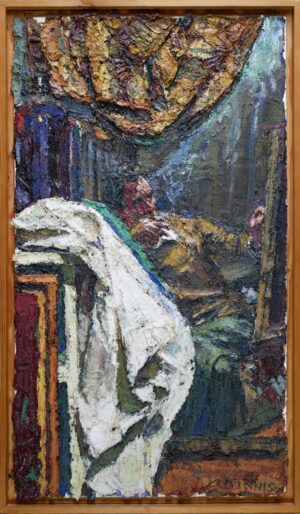Description
This photo was the first item to be pasted in the album, after the title page.
Smetham sustained a straightforward, artist-to-artist relationship with Frederick J. Shields, whom he met in 1866 and about whom he wrote to his brother the next year. ‘I have recently met in the pagan circle of Art with one man of real painting power who is also a true Christian – Shields of the Old Water Colour. This is the first time for 20 years that I have not been quite lonely in the following out of my whole plan of life’. The two men managed an extensive correspondence for several years even though Shields lived most of the time in Manchester. Like Smetham, Shields was a very pious, conscientious individual with a masochistic, overtly Calvinistic bent fuelled by ‘strenuous work and rigid self-denial’. He too kept a sacred routine and a diary (filled with cryptic annotations like W.P.B.B. – ‘wash, prayer, Bible, breakfast’) and nurtured some degree of guilt about producing art rather than sermons. Tragically, Shields also had psychological problems and in 1866 had a breakdown, followed by chloral addiction (like their mutual friend Rossetti). His later biographer remarked that ‘His Vitality was astonishing, but the intense nervous tension of years of overwork, and underfeeding, his terrible depressing views on on life, left him little strength to cope with the everyday distractions of town life.’ Noticeably indifferent to worldly success, Shields nonetheless tried to help his friend by putting him in touch with potential patrons. He and Smetham shared a common dislike of the exhibition system, of corrupt art and critics, and time-wasting. At times Smetham commiserated with Shield’s overworked, under-appreciated status, writing in 1871 that ‘I sympathise with your long toil. I see you exhausted on the 8th, and know what it means: that occult, reiterated, breathless labour which is appreciated by one man in 20000 – even of the intelligent. That having things “right” at the “price of blood”. Still it tells in the long run, and you will come out the Conqueror.’ Over the years Shields was generous with his advice and assistance with the sale of Smetham’s pictures, and towards the end suffered from a hypersensitivity to noise that seemed eerily parallel to Smetham’s own shutting out of the world as well as to his anxieties about noise expressed in his poems and other writings. As Rossetti wrote after seeing Shields at Manchester, ‘he has got such a pass now that he can only work occasionally and then stuff ears with cotton to shut out the singing of the birds’.
Even before his friend’s mental collapse, Shields expressed his admiration directly to Smetham. After extolling his ‘little oils’, he remarked to Smetham that these were ‘painted with the mind and there is very little indeed of the sort done’. He also commented the following year in a letter to Rev. R.P. Downs, editor of Great Thought: ‘It’s a blind thing if any work of Smetham is hung off the line. The managers of exhibitions ought to perceive for themselves the unique qualities of his poetic landscapes and their intrinsic value as admirable paintings – priced with the modesty which attends the want of recognition by the public. They stand alone in present Art in their unity of the action with the landscape in which the figures move emotionally. He observed that public figures like G.F. Watts and Ruskin had ‘spoken in the most unhesitating way of their rare merits … [and that Rossetti] did not know, among all the great minds … more than half a dozen of Smetham’s calibre of brain. And yet this gifted man has suffered in England a long life of neglect – though when dead, and fifty years pass by, his pictures will be raked from oblivion and life after life of him issued to an eager generation, who will be dealing just the same emphatic measure to some gifted soul of their time.’ On another occasion Shields defended his friend on different grounds, describing him as an authentic impressionist and asserting that he was one ‘long before that awkward word defined a school who have no little relation to such true powers as his’.
James Smetham Artist, Author, Pre-Raphaelite Associate – Susan P Casteras, pages 79-80.



